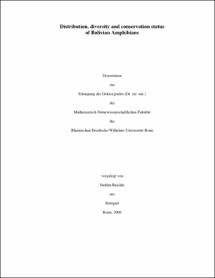Distribution, diversity and conservation status of Bolivian Amphibians

Distribution, diversity and conservation status of Bolivian Amphibians

| dc.contributor.advisor | Böhme, Wolfgang | |
| dc.contributor.author | Reichle, Steffen | |
| dc.date.accessioned | 2020-04-10T18:03:53Z | |
| dc.date.available | 2020-04-10T18:03:53Z | |
| dc.date.issued | 2007 | |
| dc.identifier.uri | https://hdl.handle.net/20.500.11811/3145 | |
| dc.description.abstract | The current work is the first comprehensive publication on the distribution and conservation status of Bolivian amphibians. For 202 species modeled distribution range maps are presented, based on 2.866 collection points, thus making an average of more than 14 collection points/ species. All maps are discussed for their accuracy and for areas of possible miss-modeling. Species richness maps are shown for all families with more than 4 species (Bufonidae, Centrolenidae, Dendrobatidae, Hylidae and Leptodactylidae), as well as an overall species richness map and an endemism richness map for all Bolivian Amphibians are presented. The emerging patterns show that the ecoregion with most endemism in Amphibians by far are the Bolivian Yungas, while the most species rich ecoregions are the Beni Savannas and South-West Amazonia, the first one because of the vegetation mosaics of savannas and forests, the second because of the variation of the altitudinal gradients at the Andean foothills. A short overview on the taxonomic problems of Bolivian amphibians is given, mainly to provide input for conservation decision makers. More than 30 species are shown to present taxonomic problems within the country. The taxa with most urgent taxonomic problems to be solved as for conservation reasons are living in mountain regions in the Bolivian Yungas. In order to be able to evaluate quickly the conservation status of each species, a new methodology based on numerical values was developed, and 223 species were assessed. Out of these, 35 species (16%) present conservation problems, five species are found to be critically endangered , eight to be endangered and 22 to be vulnerable. A distribution map for all species with conservation problems is shown, being the base for future specific conservation actions to be taken. All species with conservation problems are living in altitudes from 1.800 m asl. up to 5.000 m asl. All major conservation problems in Bolivia for Amphibians are discussed, suggesting that the biggest threats currently are land-use changes and chytrid fungus disease, between the two affecting all 35 species found to have conservation problems. Only for two species (Telmatobius culeus, T. gigas) the use and overuse of their populations is also an important factor. Other threats such as invasive species or climate change are discussed, and in the case of the latter it is suggested that this might lead to mass extinctions and a major shift of known species distributions. In a global perspective, unlike other South American countries, Bolivia so far has a relatively low number of threatened amphibians, nevertheless a reality that could change quickly, taking into account ongoing land-use and climatic changes. To secure the future of many Bolivian Amphibian species conservation action must be taken at different levels, starting with the need of habitat protection measures, especially for species with restricted distributions and the reduction of use of some species. However all these measures will not be effective if we will not be able to conserve large patches of forests in the lowlands and Andean slopes, these are most important for local and global climate regulation and will also serve as functional corridors for the displacement of species in the future. | en |
| dc.language.iso | eng | |
| dc.rights | In Copyright | |
| dc.rights.uri | http://rightsstatements.org/vocab/InC/1.0/ | |
| dc.subject | Amphibien | |
| dc.subject | Anura | |
| dc.subject | Bolivien | |
| dc.subject | Naturschutz | |
| dc.subject.ddc | 570 Biowissenschaften, Biologie | |
| dc.title | Distribution, diversity and conservation status of Bolivian Amphibians | |
| dc.type | Dissertation oder Habilitation | |
| dc.publisher.name | Universitäts- und Landesbibliothek Bonn | |
| dc.publisher.location | Bonn | |
| dc.rights.accessRights | openAccess | |
| dc.identifier.urn | https://nbn-resolving.org/urn:nbn:de:hbz:5N-11717 | |
| ulbbn.pubtype | Erstveröffentlichung | |
| ulbbnediss.affiliation.name | Rheinische Friedrich-Wilhelms-Universität Bonn | |
| ulbbnediss.affiliation.location | Bonn | |
| ulbbnediss.thesis.level | Dissertation | |
| ulbbnediss.dissID | 1171 | |
| ulbbnediss.date.accepted | 27.02.2007 | |
| ulbbnediss.fakultaet | Mathematisch-Naturwissenschaftliche Fakultät | |
| dc.contributor.coReferee | Kneitz, Gerhard |
Files in this item
This item appears in the following Collection(s)
-
E-Dissertationen (4397)




